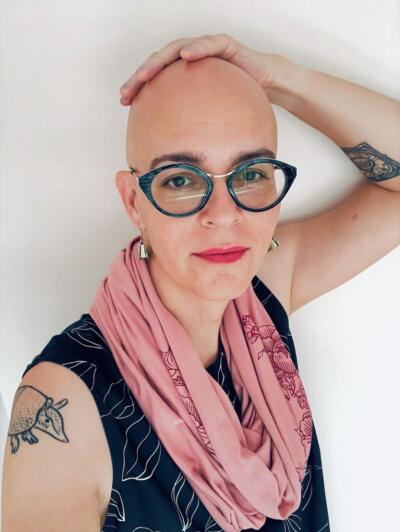1796 Rock ’n’ roll trans recall
Any Other City
by Hazel Jane Plante
Vancouver: Arsenal Pulp Press, 2023
$22.95 / 9781551529110
Reviewed by Brett Josef Grubisic
*
 Whenever film critics gripe about pop music biopics, “cliché-ridden” is standard fare. Considering a pop star’s ready-made chapters — juvenile precocity, discovery, rise and fall, triumphs and tragedies, and so on — over-reliance on genre tropes merely highlights the story’s formulaic character.
Whenever film critics gripe about pop music biopics, “cliché-ridden” is standard fare. Considering a pop star’s ready-made chapters — juvenile precocity, discovery, rise and fall, triumphs and tragedies, and so on — over-reliance on genre tropes merely highlights the story’s formulaic character.
It makes sense, then, that similar criticism would extend to the rock star memoir’s predictability: meteoric rise (and fall), heroes and villains, dark nights of the soul… plus a few ‘exclusives’ — glimpses of offstage antics and authorial clarifications about this or that notorious episode.
Tracy St. Cyr, imaginary lead of the fictional band Static Saints, mentions her sense of how rock ’n’ roll memoirs typically turn out in “Preface to Side B, or Sex, Trauma, and Rock ’n’ Roll,” a brief statement of intent midway through Hazel Jane Plante’s uneven sophomore novel, Any Other City.
Well before that, in Plante’s own introduction, “Foreword to Side A, or A Dose of Vinyl Hiss Before the First Song Starts,” the author touches on the writing of the memoir. “I’m just someone who chatted with her,” Plante notes, “and provided some feedback on her blueprints and architectural models…. I was just along for the ride as a pedantic passenger, a light-fingered creative conspirator.” Besides rearranging St. Cyr’s notes into “a useful and beautiful shape that feels something like a life,” Plante indicates prospective goals of the book-to-come. “Perhaps we could show how it feels to travel through time with a complicated gender, including the ways our past selves ripple into our present selves,” Plante comments. And: “The aesthetic and architectural decisions animating this book stem from the desire to make it as useful and beautiful as humanly possible.”

120 pages later, St. Cyr recalls a different initial impulse: to “stitch together a memoir that wasn’t cut from the same sad cloth as every other musician and trans girl.” Years passed before St. Cyr landed on a worthy idea. “I imagine my memoir as a skyscraper with an elevator that only stops at the twentieth and forty-sixth floors,” she shares.
Viewed another way, floors 1-19 and 21-45 are off-limits, inaccessible, out of sight. That’s an autobiographical account missing about 97% of its subject’s life.
For readers curious about the full life of a rock ’n’ roll trans girl, those floors could prove fascinating, informative, edifying, and entertaining; they’d sate a fan’s desire to know. And, particularly for any fan who’d choose to shell out for a musician’s memoir, surely a contract of broader revelation would be assumed. So, while St. Cyr’s memoir relates the applause-worthy process of a soul overcoming restrictions (she exclaims, “I want to show how I write songs, how I process trauma, and how I fuck. These things feel deeply important. I’m fed up with fear. I’m tired of shouldering shame”), a reader with conventional expectations for a memoir might feel thwarted.
Interestingly, St. Cyr shows that disavowed memoir in embryonic form. In the second part of Any Other City, she encounters a former girlfriend. Eager to explain what occurred over the previous decades, St. Cyr taps out some notes — “to trace the dots” — on her phone:
How I stumbled around in a fog of confusion for so many years.
………..How I broke this stasis by starting a PhD program in art history.
………………….How I was going to study trans artists, including Sadie Tang.
……………………………How I dropped out after a couple of years.
……………………………………..How my gender shit kept bubbling up.
How I got married.
………..How I eventually told my wife that maybe I was trans.
…………………..How she and a therapist convinced me that I wasn’t.
……………………………How I stopped painting.
……………………………………..How I bounced aimlessly between jobs.
……………………………………………….How I really got into hot yoga.
……………………………………………………….How I grew one denial beard after another.
The tantalizing details continue for two further pages. Although these “dots” appear to represent the basis for a memoir of the “same sad cloth” type that St. Cyr spurns, it’s an open question if her snubbing of convention is an innovation worth preserving.
*
St. Cyr’s “Side A,” the “twentieth floor,” is set in 1993 and recounts a turbulent formative period in late adolescence.
An aspiring artist who paints when not working at a bakery, he’s alone in an unnamed foreign metropolis — “of strangers and serpentine alleys,” of “endless alleys and camouflage leather skirts.” St. Cyr recalls longings to be more than a Sunday painter and to become someone beyond his current gender. St. Cyr chronicles a deep yearning for safe familiarity (for hometown and girlfriend), but acknowledges “my body won’t let me.”
Following an unsuccessful application at the exotic city’s famous art school, he adopts the name Tracy and finagles an interview with Sadie Tang for a fabricated radio program. An esteemed trans artist and globe-trotting professor at the school, Tang agrees. She soon discovers Tracy’s lie but takes pity. As Tracy’s newly appointed mentor, Tang assigns projects. Tracy’s art-making and self-fashioning efforts are earnest but hit-and-miss; they’re undermined too by a romance at home that weakens and dies.
“Love is fucking messy,” St. Cyr reaffirms some 26 years later. Once again, love has proven ruinous.

St. Cyr is a “muddle of emotions” and feels like an “emotional geyser” in Side B. It’s 2019, she’s returned to the labyrinthine city of 1993, and — a “tsunami of anger,” “a snowdrift of bleakness and blindness,” and “caught in a trauma trap” — reels from heartache after a pain-filled breakup with Johnny, last seen as a “mess of rage and sorrow in motorcycle boots.”
The city, with its anonymity, strangeness, and its abundance of queer spaces, offers respite (from Johnny, from her past) and a rich, restorative environment.
Ruminative, St. Cyr begins to write new music. She pores over her past with Johnny and meets sexually adventurous trans women, embarking on a series of supremely erotic dates she relates in vivid detail. Less successfully, she grows rhapsodic about bands (some real, some imaginary) and songs she composes. For example, St. Cyr enthuses, “‘Even Your Charms’ had a defiance that I loved, but this song was profoundly vulnerable. I’d never written such an honest, unadorned song before” and “I called it ‘Broken Open.’ It felt softer and rawer than anything I’d ever written.” Similar to descriptions of galleries art pieces galleries in “Side A,” the material’s substance often stays elusive and inert. A song might be profound or honest or raw, but St. Cyr and her “creative conspirator” struggle to imbue them with much magic; they’re words on a page.
St. Cyr purposely chooses a narrow focus in Any Other City. And while her purpose — “I want to show how I write songs, how I process trauma, and how I fuck” — is worthwhile enough, the accounts flirt with redundancy. An erotic series is a series, after all, and one arousing encounter followed by a second and third does not guarantee automatic appeal. Likewise, though St. Cyr is adept at noting the tsunamis and snowdrifts and geysers of her emotional state, they too are a series that don’t necessarily remain wholly captivating one after the next. Song lyrics, explosive orgasms, and volatile emotional states aside, St. Cyr doesn’t appear to have much to say, especially since she’s elected to skip over other dots of her four-and-a-half decades. And as with any solipsist fascinated by every mote of their consciousness, a small dose is plenty.
*

My Two-Faced Luck, the fifth novel by Salt Spring Islander Brett Josef Grubisic, published in 2021 with Now or Never Publishing, is reviewed here by Geoffrey Morrison. A previous book, Oldness; or, the Last-Ditch Efforts of Marcus O (2018), was reviewed by Dustin Cole. Editor’s note: Brett Josef Grubisic has recently reviewed books by Sam Wiebe, Joseph Kakwinokanasum, Chelene Knight, Lyndsie Bourgon, Gurjinder Basran, and Don LePan for The British Columbia Review. A previous book by Hazel Jane Plante, Little Blue Encyclopedia (for Vivian), was reviewed by Paul Headrick.
*
The British Columbia Review
Interim Editors, 2023-24: Trevor Marc Hughes (non-fiction), Brett Josef Grubisic (fiction)
Publisher: Richard Mackie
Formerly The Ormsby Review, The British Columbia Review is an on-line book review and journal service for BC writers and readers. The Advisory Board consists of Jean Barman, Wade Davis, Robin Fisher, Barry Gough, Hugh Johnston, Kathy Mezei, Patricia Roy, Maria Tippett, and Graeme Wynn. Provincial Government Patron (since September 2018): Creative BC. Honorary Patron: Yosef Wosk. Scholarly Patron: SFU Graduate Liberal Studies.
“Only connect.” – E.M. Forster
5 comments on “1796 Rock ’n’ roll trans recall”